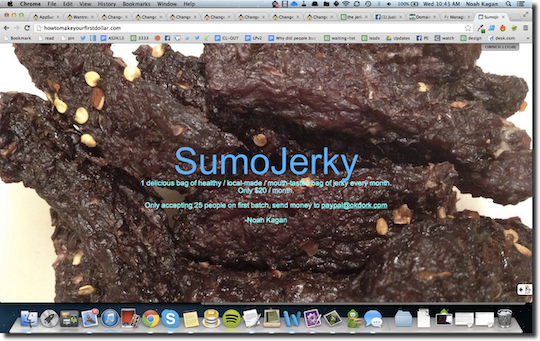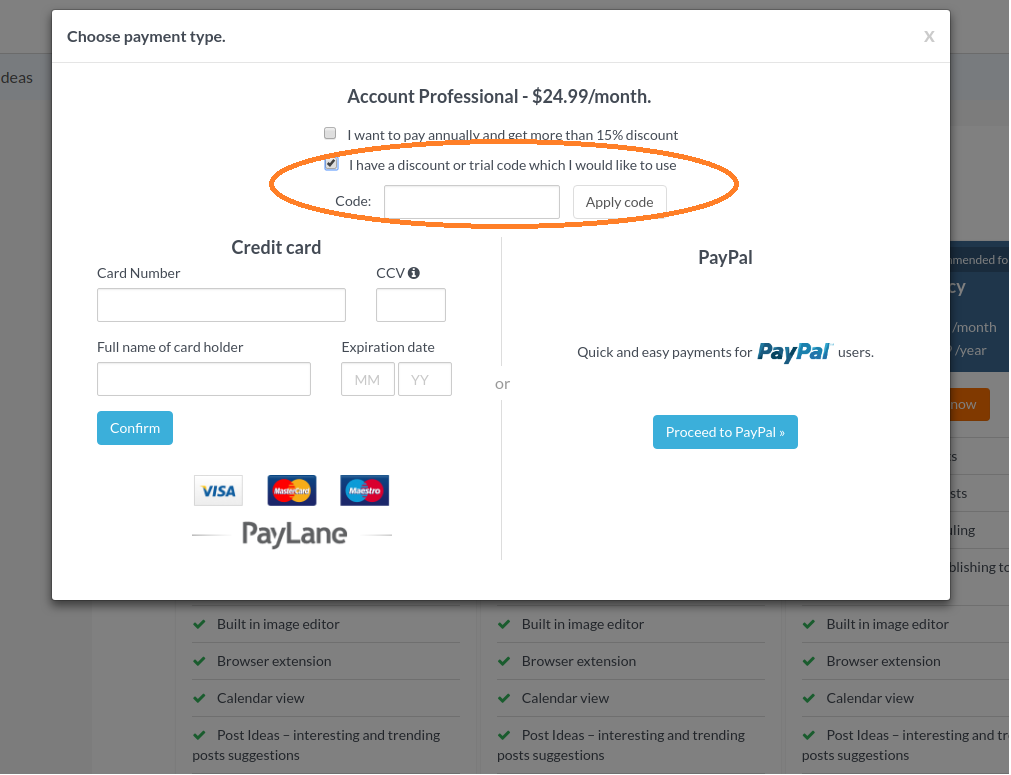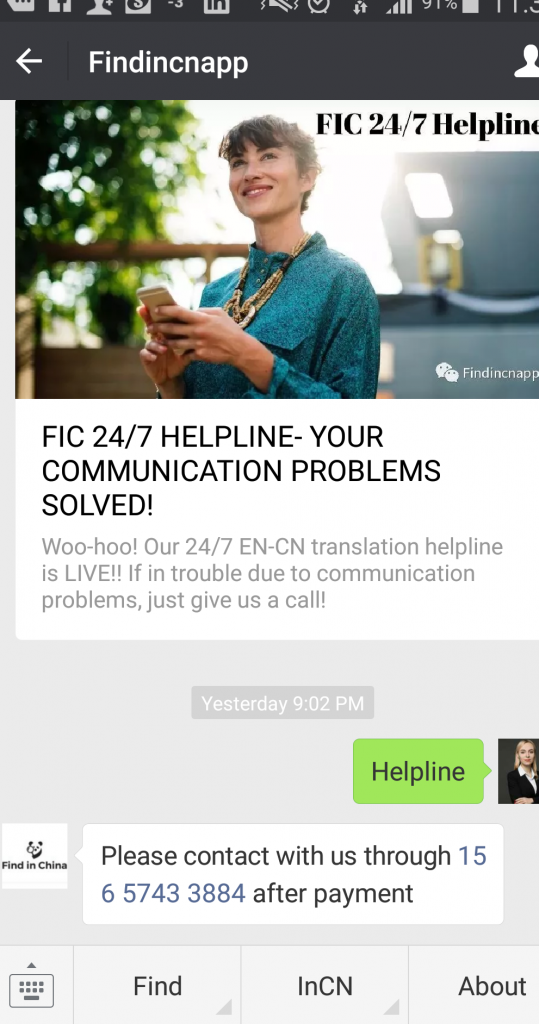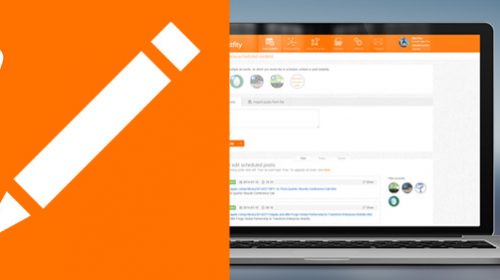Can you start a business using just social media, in less than a week, without a website or an up-front investment?
The case studies of such household names as Noah Kagan, Dan Norris, as well as no-namers like me leave us with no doubt: Yes, you can!
You don’t need a fancy website, app, or a massive marketing budget to start a business using social media, start selling in 24 hours, and make your first $1000 within a month. All you need is a clear plan, willingness to work hard and a few hundred friends in your network.
Perfectly doable if you are persistent.
In this post we will analyse three case studies of how people started a business using social media in just 24 hours, and then present a formula you can follow too!
Let’s dive into all the gory details:
1. Noah Kagan and the Beef Jerky
2. Dan Norris and WP Curve
3. My story of starting a subscription business using social media
4. How to launch your first business using social media — a step-by-step formula
Noah Kagan and the Beef Jerky
SumoJerky.com started as an experiment to prove that you can launch a profitable business in 24 hours.
It was part of Noah Kagan’s online course on How to Build a Business, which generated over $ 1,000,000 in sales.
Kagan started the Beef Jerky subscription business in 24 h in a bid to prove that the course really works on a real case study.
(If you haven’t heard of Noah Kagan before — Kagan joined Facebook as a product manager (and employee NO. 30) in 2005, and got sacked after 8 months for inadvertently leaking company secrets to TechCrunch. As his vesting period wasn’t over by then, he walked away with nothing. It didn’t stop him in his tracks though. After his $100 million dollar lesson Kagan went on to start two multi-million dollar businesses: Appsumo and Sumo.com)
To make the challenge more authentic: Kagan could not use his existing audience or mailing list when starting the business.
But let’s dive into the details:
How Kagan started a business using social media, and made $1000 in 24 h
To launch his busines using social media, Kagan took the following steps:
- Decided on a business model — a subscription-based Beef Jerky online store. Basically, you get a supply of your favourite beef jerky delivered to your desk every month for $20/month for 3 months.
- Bought a domain on GoDaddy for $0.99. Pro-tip: don’t overthink your domain name. It really matters less than you think:
“A common pitfall is people over-thinking their name when they’ve made no profit. People just want the solution and could care less what you’re called.” [Source]
- Created a very simple guerilla landing page (you can do it in WordPress or MailerLite in less than half an hour! Once you have a proof of concept you can outsource proper website development to a real webmaster) Again, don’t overthink the landing page design. Simply choose one of the templates, which are already designed for particular industries.
- Did market research to come up with the business’ unique value proposition. He talked with his target customer to figure out what will bring them most value:
“A few key questions I used in helping figure out what it would take to get them to give me money:How often do you eat jerky?Where and how do you decide to buy your jerky?What would make you pay for jerky right now?What’s your hesitation in not buying right now?” [Source]
This will help you understand your clients’ reasoning and handle rejection when selling:
Tip: When selling, a key thing is to get to the root of the rejection and see if you can solve that.
- Created a budget to see what amount of sales was needed to make $1000 (considering the profit margin).
- Created an ideal customer avatar to understand WHO his ideal customer was and WHERE he could find them. “Who I decided to go for: Offices for healthy snacksYoung professionals who already eat healthily”
- Did quant-based marketing spreadsheet — to see how many people in the target group he should contact in order to make the number of sales required hit the $1000 profit target (considering the expected conversion rate).
- Updated the spreadsheet during the day with real-time sales data and adjusted the numbers for the real conversion rate.
- Started reaching out to the potential target customers using social media. He started from posting on all his social media and then contacting the people who reacted to the posts via DMs. You can optimise the process by using Postfity.com to post on all your social media at the same time. Try the highest account for 30 days for FREE with the code ‘Academy 2019’)
10. Asked for referrals and made sure it’s really easy for people do make them:
“A key thing is to make referrals EASY for the other person to do.
1. Here’s the email I provided for people to forward to friends:
Hey Guys
Hope you’re all doing insanely well.
A good buddy of mine is starting a neat service to send 1 amazing bag of beef jerky every month.
I signed up for $20 / month for 3 months (which is enough jerky for every day). It’s only $0.67 a day for some good snacking…
He’s only taking a certain amount of people for this first run. Thought I’d hook y’all up.
Who else is in?
Keep it real.
-Anton
Ps. Any of you work in offices or know of offices who buy snacks? This is perfect for that.” [Source]
11. Asked people in the target group to post about his business on social media. Remember that posts posted by users have a much higher organic reach than posts posted by business pages — read more about it in our recent post here.
Again, it’s important to make this super-easy for your referrers by providing a template:
Here’s how Noah did it:
Attention Beef Jerky Fans! My buddy Noah is launching a beef subscription jerky service. He is crazy and so are you for loving beef jerky. Check it out: http://sumojerky.com/
12. Searched his Facebook network for friends who like paleo, health or jerky and messaged them with an offer to subscribe.
13. After 9 hours of hard work like that, supported by quantified targets — Noah made:
“$3,030 in total revenue
$1,135 in profit” [Source]Bottom line:
“The secret to success … is work. That’s it. It’s hard and tiring but if you want it, you can do anything.
What it all boils down to is yourself. If you really want it and are willing to work, the lifestyle you want is available to you.” [Source]
Dan Norris and WP Curve
Dan Norris described his journey from almost-broke to a seven-figure business which he launched in only 7 days in his book ‘7-day Startup — You Don’t Learn Until You Launch’.
Dan Norris is a serial entrepreneur.
His first ‘serious’ business was a web development agency. He spent 8 years building it, only to find that he couldn’t scale it no matter what. His profits remained flat at around $40,000.
By the time he turned 30, Dan was fed up with his business. He was earning less money than his friends in jobs and seemed stuck. He decided to sell the business and use the money to grow something more sustainable — a scalable Software-as-a-Services (SaaS) business.
And so he did.
After considering a few options, he decided to build an app aggregating analytic from different places — and presenting them in a simplified dashboard.
He called the startup ‘Informly’.
The beginning was promising: he got a lot of newsletter and FREE trial signups, enthusiastic press coverage, and built a great development team — all bootstrapping from the money he got for selling the agency.
And then, almost a year of burn into the project, the pretty harsh truth became obvious:
Even though people were signing up for the free trial, nobody really wanted the product — “There is a very big difference between someone entering their email and someone paying you each month for a product.”
“After 11 months of trying everything I was earning only $476 in recurring monthly revenue and spending $2000+ a month. I had burnt through all the money I made on the first business and was two weeks away from running out. I started looking at jobs…”
With only 2-weeks’ worth of savings in the bank, and the prospect of having to move his entire family back to the city and find a job ASAP, Dan decided to give himself a last chance:
To launch another business, which would have obvious utility, would be instant to launch and would bring in money immediately.
Using experience from his web development agency, he launched a WordPress Support Service, which offered unlimited help with small WordPress jobs for a flat fee of $69 per month.
And he got the first customer the very same day.
“In the first week, I signed-up 10 customers. This resulted in $476 in recurring monthly revenue, which was the exact amount I worked up to during the previous 10 months with Informly.”
How come a startup that cost almost nothing and took only a few days to launch, could make the same revenue in 7 days as a sophisticated (and expensive!) app in 11 months?
It had a practical utility that could be easily validated.
So, how did Dan Norris launch his new business in just 7 days?
Day 1 — come up with an idea – define the market, ideal customer avatar, and unique value proposition
Day 2 — create some kind of a Minimum Viable Product (MVP); this can be a video, or a mock-up, or a manned-process (see my helpline story below) that would be automated in the future;
Day 3— Come up with your business name, buy a domain
Day 4 — Build a simple landing page
Day 5 — Define your KPIs and KSIs (= quantifiable sales spreadsheet – how much you need to sell to make a living considering your profit margin, how many people you need to reach to sell given your expected conversion rates)
Day 6 — Launch using Social Media
Bottom line:
“The biggest mistake people make is obsesssing over their idea and not finding enough people willing to pay for their product” [source — The 7 Day Startup, p.7]
How to start a business using social media? My story
A few wrinkles ago, when I was in China, I went to a startup weekend, hoping to change the lives of millions of people (of course).
Let’s make one thing clear: being an expat in China without speaking Mandarin really sucks.
Of course, you can leverage the difference in prices and live like a king off your western salary. But when it comes to communication and finding your way around, living in China is an absolute nightmare for two reasons:
-
“Nobody speaks English!” — me, circa 2016;
-
The internet is blocked by the Chinese government, and to access Google, Google Translate or Google Maps, you need a VPN, which sometimes, works, and sometimes doesn’t.
…which means you have to make to with Chinese apps, maps and everything else which is available, well…pretty much only in Chinese.
As a result, simple everyday activities like telling a hairdresser what you want, finding your way to a toilet in a shopping centre or getting from A to B (because the bus timetables are also in Chinese, and you won’t find a taxi driver who speaks English) amount to a massive challenge.
My adventures with the language barrier in China were so hilarious I even wrote a who
And when it comes to emergencies, it’s really scary.
It wasn’t until I had my wallet stolen during a weekend-trip to Harbin that I learnt exactly how scary it can be.
Having all my cash, cards and documents stolen, I was left all alone in the far north. I tried calling the police, but again — nobody spoke English.
I tried blocking my bank card online — but I couldn’t understand the helpline instructions.
If it wasn’t for my Chinese business partner back in Ningbo, I would have been really stuck.
That’s how I came up with the idea of launching a 24/7 language helpline and turning into a subscription business.
At that time, me and my business partner were working on an app for expats in China — Find in China, aggregating events, venues and services on a map in English.
But while we were waiting for the developers to finish the backend, we needed some quick cash.
My debacle in Harbin, background in translation studies, and the fact that I was reading Dan Norris’ ‘7-Day Startup’, prompted me to quick action: let’s start a 24/7 translation helpline for expats!
Briny, my business partner, was less than thrilled though. We didn’t have a call centre, we didn’t have staff (apart from my business partner), we didn’t have a marketing budget.
What we did have tough was:
- two working businesses (in China and in the UK) with PayPal and AliPay business accounts
- an audience of around 1500 expats across our two WeChat groups, WeChat account followers, Facebook Page followers and on Instagram
- our network — lots of connections in other expat groups and organisations, as well as on LinkedIn
How to start a business using social media? What we did step by step
- We bought a new mobile phone number online
- We put up a simple landing page using my WordPress website. You can also use an email marketing tool MailerLite instead of a sales page — explaining the need, concept, pricing plans, payment methods, and terms and conditions.
- We pasted our AliPay and WeChat Pay QR codes into the landing page to allow instant payments, linked my business PayPal account link (https://www.paypal.me/) for those that wanted to pay us with PayPal/ Credit Cards; we were not able to set up a recurring payment, so we discounted the 3-month option to get more signups and more cash in up-front.
- We used content to promote our helpline – we wrote longer posts explaining the need for the Helpline for all our social media: Facebook, Instagram, Twitter, LinkedIn and WeChat (you can use Postfity.com to cross-post on all your social media at the same time — except WeChat. Now you can also use the highest account for 30 days for FREE with the code ‘academy 2019’)
- We created a referral system (we used mirror-pages with unique codes to track clicks from each one) and recruited 22 referees who:
- Shared our posts about the helpline launch on their social media: on their WeChat walls, in the WeChat groups they belonged to,
- Shared information about the helpline to expats in their network and offered a unique discount
We valued our 1-month plan at 49.99 RMB ($ 7.99) or 29.99 RMB ($4.99) per one-off call.
That same evening we launched, we got our two first clients for the 1-month plan.
We went on to get 7 more clients that week, grossing 449.99 RMB in Recurring Monthly Revenue.
Not bad for a stop-gap solution that took us two days to launch.
How to launch your first business using social media? A step-by-step formula
As you have already noticed from the three case studies above, there is a clear pattern you can follow to launch a profitable, simple business within 7 days (or sometimes as little as 24 hours!):
- Come up with a business idea that has a high utility, but that does not require a huge time and money investment to launch as an MVP.
- Analyse the market — your ideal client avatar and their needs; understand what they are really willing to spend money on — and then validate the unique value proposition by asking for the money as soon as possible.
- Come up with a business name and buy a domain — don’t spend too much time on it. It’s less important then you think.
- Put up a simple landing page for your project. You can use WordPress.org template or even easier landing pages from your email marketing tool. Use a simple payment system, e.g. PayPal button, to collect payments on your landing page.
- Come up with a quant marketing strategy: calculate your margin, how many people you’d need to sell the product/service to to make you your money target (e.g. $ 1000/ month), and how many people you’d need to reach to make the required number of sales to hit your profit target (e.g. considering an average conversion rate of 5%, you need to reach 100 people to make 5 sales.)
- Post on your Social Media. Post on all of your profiles several times, tweaking the message each time to see what works best. Use a social media scheduler to streamline the process.
- Ask friends to post on their Social Media profiles.
- Create a referral system — make it really easy for the referees to share your message by creating message templates for email and social media.
- Create KPIs and KSIs for your campaign, measure and update your marketing strategy with real sales data (esp. conversion rate) as you go.
- Look at your network and what people in your network are interested in. Reach out to as many people in private messages as you can. Hustle. Don’t stop. 😉
Good luck speed-launching your businesses — let us know in the comments how it went! 🙂













